Reframing Agriculture In The Climate Change Discussion
Author: Alice Cunningham | Published: November 16, 2016
When it comes to climate change, the problem and the solution may be one and the same.
This week in Marrakesh, government leaders will meet for the last leg of the UN Climate Change Summit (COP 22) and it is clear we are at a critical moment in our history. Man-made changes to the climate threaten humanity’s security on Earth. Though we are taking steps globally to reduce emissions from industry, transportation and heat production, another source accounts for 24 percent of total global greenhouse gas emissions, according to the EPA.
That problem is farming.
Agriculture is the largest-single contributor to the climate crisis. The UN’s 2013 Trade and Environment Review points to agriculture as responsible for 43-57 percent of human-generated greenhouse gas emissions. The current degenerative farming system results in the loss of 50-75 percent of cultivated soils’ original carbon content. By destroying soil nutrients through the overuse of chemical fertilizers and pesticides, conventional agriculture jeopardizes food security and nutrition, and reduces ecosystems’ resiliency to flood and drought by removing the protective buffer provided by soil’s organic carbon.
Industrial agriculture is additionally responsible for large-scale degradation through factory farming, waste lagoons, antibiotics and growth hormones, GMOs, monocultures, and prolific use of chemical pesticides and fertilizers. But there is a biological process for reversing this damage and providing climate stabilization that’s tried and tested, available for widespread dissemination now, costs little and is locally adaptable.
That solution is farming.

